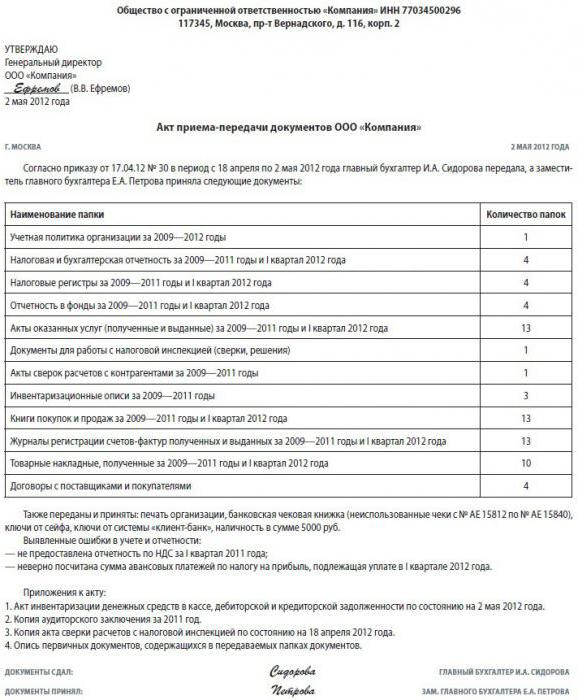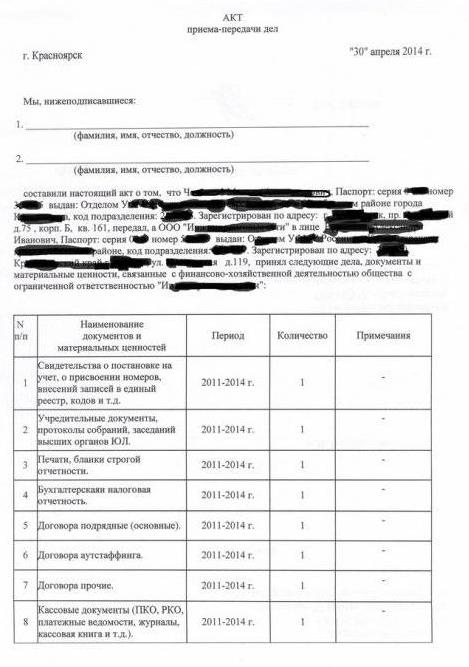A document called the “Act of Acceptance and Transfer of Cases” is familiar only to those who have ever held senior positions. The rest know about him only by hearsay. And it is very unlikely that someone will be able to compose it yourself.
Main reasons
At any enterprise, things are usually taken for several reasons:
- Assignment for each specific area of responsibility.
- Assessment of the total amount of work to be performed by a newly hired employee.
- Temporary performance of duties for a currently absent employee.
- Organization of continuous work.
But the reason for transferring them from one employee to another may be:
- long business trip;
- prolonged stay on sick leave;
- maternity leave;
- transfer to another job;
- dismissal of an employee.
In these cases, one of his colleagues takes upon himself the duties of the retiring employee, and an act of reception and transfer of cases is necessarily drawn up.

It usually lists all the documents that were kept by the dismissed person. In addition, the act of reception and transfer of cases contains a full description of the work done, and all identified deficiencies are separately noted. The document is compiled necessarily in two copies, one of which is filed in the personal file of the retired employee, and the second remains in the department, that is, with the new owner.
Difficult situation
Interestingly, the initiator of such an action, as a rule, is the director. After all, he, along with the newly-found part-time worker, is interested in putting things in order. But sometimes such a situation arises that the old worker leaves without signing the deed of transfer of affairs. This can happen due to a combination of circumstances or intentional delays. Sometimes an employee, knowing his shortcomings, delays especially on time. After all, everyone knows that the leader cannot delay his work record or the final calculation, but is obliged to give it all on the day of dismissal. The employee simply leaves, and the employer is forced to look for a way out of this situation. What should a new owner do if he gets an orphaned object? In this situation, do not be upset. You just need to take matters in fact, so as not to be responsible for the mistakes of others. Sometimes the director as an intermediate step temporarily takes matters over, and only then transfers them to a new employee. It may be so, but still you need to remember responsibility for the actions committed.
Chief Accountant Replacement
The assumption of the new head of accounting is preceded by six important steps:
- Issuing an order signed by the director, in which he stipulates the entire sequence of actions and the procedure for the future transfer of cases. Depending on the reasons for the dismissal of the former specialist, the employees have at their disposal no more than two weeks.
- The current chief accountant must complete all current affairs by the scheduled time (make the necessary notes, fill out primary documents and draw up reports). Paper should be framed and stitched.
- Conducting an inventory.
- Auditing.
- Work Transmission.
- Entering information about the new accountant in all sources.

It doesn’t usually look like the act of receiving and transferring cases when changing the chief accountant. The sample contains a huge list of issues to which you need to pay close attention:
- Organization of the work of all accounting, as well as the general characteristics of accounting in the company.
- The accounting status of all settlement transactions.
- Accounting and movement of all cash.
- Material accounting and depreciation calculation.
- Settlements with employees.
- Account balances.
- Source documents.
- Forms of strict reporting.
- The state of affairs in the archive.
- A list of missing documents and explanations on this fact.
Only after that the act is signed, which means, in essence, the assumption of office.
New leader
Replacement of leadership usually begins with a general meeting of the founders. The decision made on it is drawn up in the form of a protocol or an order. This information is immediately transferred to the tax inspectorate, and only after that the main procedure begins, the result of which will be an act of acceptance-transfer of cases. When changing the director, it will be more voluminous.

Such a document, as a rule, consists of 3 parts:
- Introductory. It contains information about the place and time of the meeting, as well as information about the representative from the general meeting.
- Descriptive. It includes a complete list of documents that are transferred to the new director. This list is very long. This includes, first of all, constituent documents, certificates and registration data. Then there are agreements with banks and all additional agreements to them. After this comes the turn of orders for the enterprise. They are followed by contracts relating to the core business of the company. Next are accounting reports, cash documents and information on securities. At the very end of the list is documentation on safety, health and fire safety. After them, there remains only correspondence with state and regulatory bodies, and finally - a journal of the movement of labor books.
- The final one. It lists all those present who put their signatures.
The last point will be the round stamp of the enterprise.
